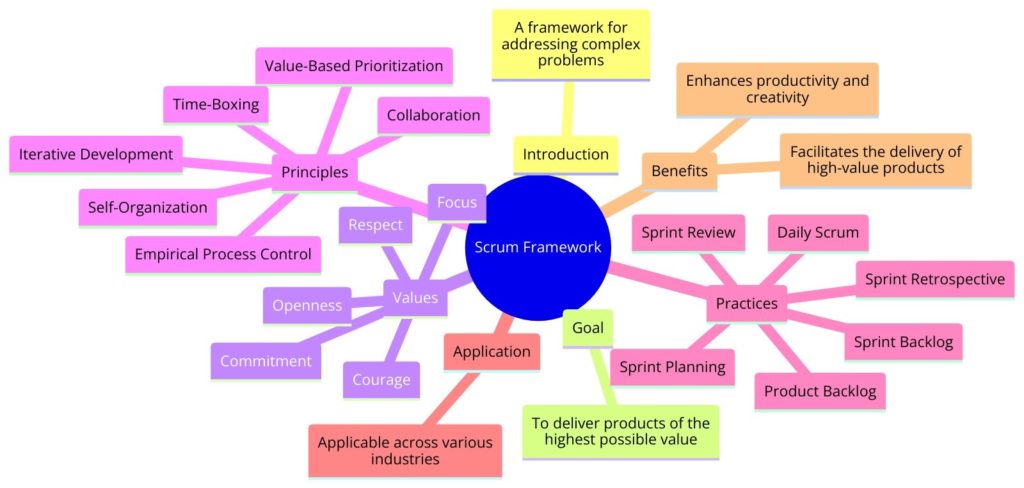Scrum Model
The Scrum Model is a framework for agile project management that focuses on teamwork, accountability, and iterative progress toward a well-defined goal. It is one of the most popular and effective methodologies used for managing complex software and product development projects that require rapid changes and flexible response strategies. The framework structures development in cycles of work called Sprints, providing a process for delivering products in a controlled, agile manner.
What is the Scrum Model?
Scrum is based on a set of values, principles, and practices that allow organizations to address complex problems while productively and creatively delivering products of the highest possible value. It is not a technique or a definitive method for building products; instead, it is a framework within which you can employ various processes and techniques. Scrum makes clear the relative efficacy of your product management and work techniques so that you can continuously improve the product, the team, and the working environment.
Origin of the Framework
The Scrum Model was first introduced in the early 1990s by Ken Schwaber and Jeff Sutherland, drawing from their experiences in product development and influenced by the 1986 Harvard Business Review article “The New New Product Development Game” by Hirotaka Takeuchi and Ikujiro Nonaka. They presented Scrum as a more flexible and adaptive approach to product development than traditional waterfall methodologies. It has since been adopted widely across various industries, not just in software development.
How It Works
The Scrum framework is defined by several key components: roles, events, artifacts, and rules. The three primary roles within a Scrum team are:
- Product Owner: Responsible for maximizing the value of the product resulting from the work of the Development Team. They manage the Product Backlog and ensure that everyone knows the priorities.
- Scrum Master: Ensures that the team lives by the values and practices of Scrum. They act as a facilitator and coach, helping the team work together in the most productive and efficient manner.
- Development Team: A cross-functional group of professionals who deliver product increments within a Sprint. They are self-organizing and multifunctional, with all the skills necessary to create a product Increment.
Scrum is executed in Sprints, which are fixed-length iterations of one month or less, within which a “Done,” usable, and potentially releasable product Increment is created. Scrum employs four formal events for inspection and adaptation, as follows:
- Sprint Planning: Planning the work to be performed during the Sprint.
- Daily Scrum: A 15-minute time-boxed event for the Development Team to synchronize activities and create a plan for the next 24 hours.
- Sprint Review: A review at the end of the Sprint to inspect the Increment and adapt the Product Backlog if needed.
- Sprint Retrospective: An event after the Sprint Review to inspect the past Sprint and plan for improvements to be enacted during the next Sprint.
Why It Is Valuable
Scrum is valuable for several reasons:
- Flexibility and Adaptivity: Allows for rapid changes and adjustments throughout the development process, responding quickly to feedback and changing requirements.
- Increased Productivity: Through regular and clear communication, focused work periods (Sprints), and continuous progress assessment (Daily Scrum), teams can work more efficiently.
- Stakeholder Engagement: Regular reviews and updates keep stakeholders involved and informed, ensuring that the final product meets their needs.
- Risk Reduction: Regular reassessments of project priorities and progress help identify potential issues early, reducing risks.
When and How to Use It
Scrum is particularly useful in projects with rapidly changing or highly emergent requirements. It is widely used in software development but can be applied to any field requiring project management, including product development, marketing, and event planning. Implementing Scrum involves:
- Assembling a capable team comprising the Product Owner, Scrum Master, and Development Team.
- Defining the product vision and creating an initial Product Backlog.
- Planning and executing Sprints, including all Scrum events (planning, daily stand-ups, reviews, and retrospectives).
- Continuously inspecting and adapting the project based on feedback and the results of Sprints.
Shortcomings/Criticisms
While Scrum is highly effective, it is not without its criticisms:
- Over-reliance on Team Autonomy: Teams with insufficient experience or discipline may struggle without more structured guidance.
- Scope Creep: Without careful backlog management, the iterative nature of Scrum can lead to scope creep.
- Not a Silver Bullet: Scrum may not be suitable for all types of projects, particularly those with fixed requirements or those that are highly dependent on individual tasks that cannot be easily divided into Sprint-friendly chunks.
The Scrum Model offers a robust framework for managing complex projects through its emphasis on flexibility, collaboration, and continuous improvement. While it requires a significant shift in mindset from traditional project management methodologies and may not be universally applicable, its benefits in fostering a productive and adaptable project environment make it an invaluable tool for many organizations.


